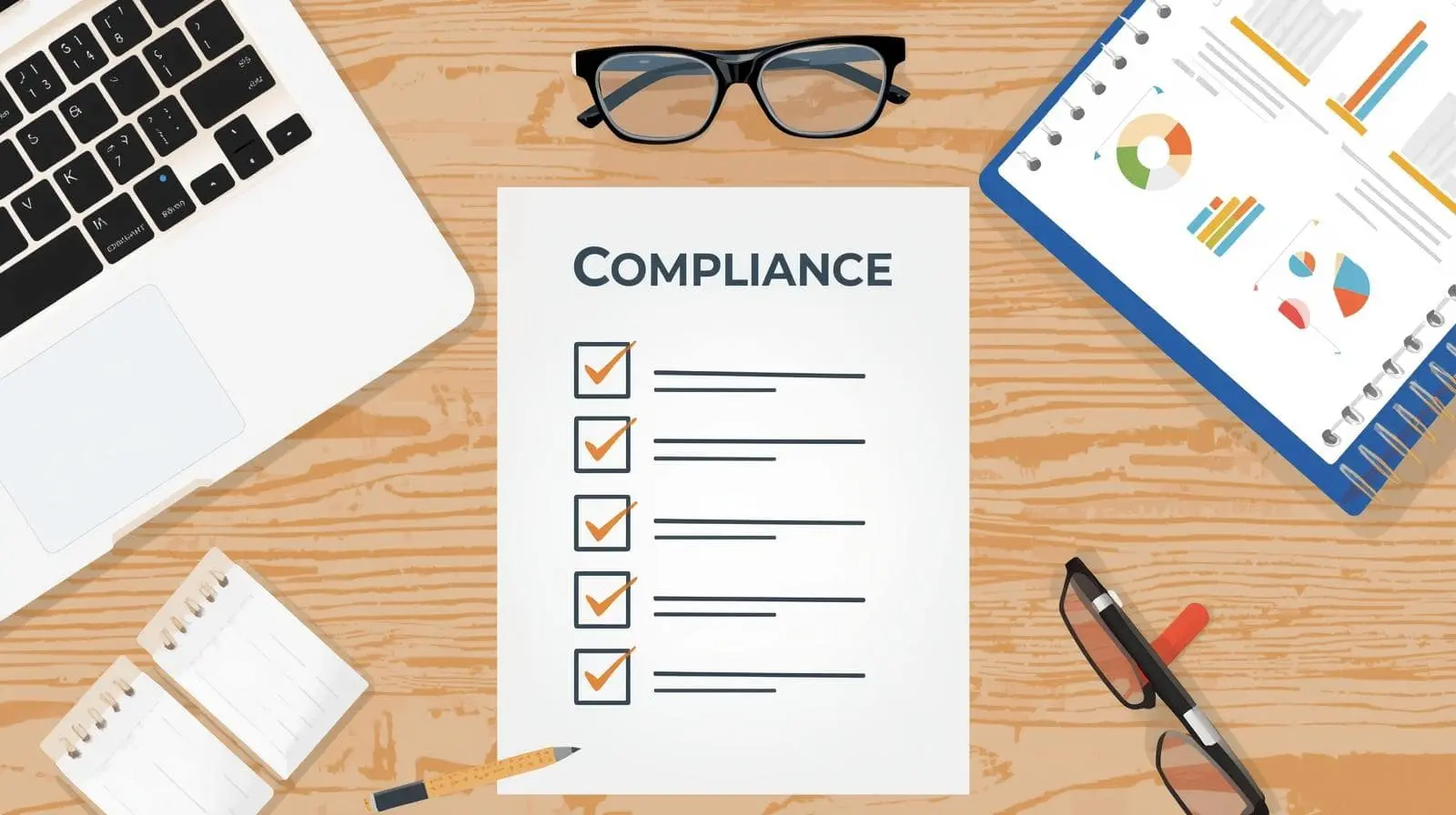The Ultimate Compliance Checklist for Small Business Owners
A comprehensive guide to building and maintaining your business compliance program. Learn what documents you need, when to renew them, and how to avoid costly penalties with proven strategies from industry experts.

Aaron Kushner is an entrepreneur with decades of hands-on experience running service companies and eCommerce operations. He founded DocuStrong to solve the compliance and document-tracking challenges he faced firsthand in the field.

Last month, a catering company in Portland received a $15,000 fine for operating with an expired food handler’s permit. Three days later, a construction firm lost a $200,000 contract because they couldn’t produce current insurance certificates during a client audit. These aren’t isolated incidents-they’re preventable compliance failures happening daily.

In both cases, a centralized, automated renewal reminder system could have prevented the crisis for less than the cost of one missed deadline.
Most small business owners aren’t non-compliant because they don’t care. They’re non-compliant because compliance is overwhelming, scattered across systems, and buried under daily operational demands.
This guide provides a practical, actionable compliance checklist for small business owners. You’ll learn which documents your business needs, how to organize them, when renewals are due, and how to build a compliance system that works-without hiring a compliance officer or drowning in paperwork.
What Is Business Compliance and Why Does It Matter?
Business compliance means meeting all legal, regulatory, and industry-specific requirements that apply to your operations. This includes maintaining current licenses, permits, insurance policies, certifications, and contracts-and producing them on demand when regulators, clients, or partners request them.
Compliance protects your ability to operate, win contracts, secure financing, and avoid penalties. According to the U.S. Small Business Administration, the average small business needs 5 to 15 different permits and licenses just to open-with that number growing significantly in regulated industries.

The National Federation of Independent Business reports that regulatory compliance can cost small businesses up to $12,000 per employee annually, with penalties adding thousands more. Beyond financial impact, compliance failures result in:
- Operational shutdowns: Immediate suspension for expired permits
- Contract losses: Clients require proof of current insurance and licenses
- Reputation damage: Violations become part of your business record
- Legal liability: Voided insurance and personal exposure
- Lost productivity: Time diverted from revenue-generating activities
A systematic approach eliminates these risks and creates competitive advantages. DocuStrong helps businesses manage compliance requirements systematically, reducing the administrative burden by 70% while ensuring nothing falls through the cracks.
In short: Maintaining updated licenses, permits, and insurance protects your business from fines, shutdowns, and contract losses while positioning you to win more opportunities.
Ready to Simplify Your Compliance Management?
Start tracking all your licenses, permits, and insurance in one place-with automatic renewal reminders.
Get Started Free →At a Glance: Essential Compliance Documents by Category
Here’s a quick reference showing the most common compliance documents small businesses need, organized by category:
| Document Category | Common Examples | Typical Renewal Frequency |
|---|---|---|
| Business Licenses | General business license, professional licenses, industry-specific permits | Annual to 3 years |
| Insurance Policies | General liability, workers’ comp, professional liability, commercial auto | Annual |
| Health & Safety | Health permits, fire inspections, OSHA compliance, environmental permits | Semi-annual to annual |
| Employment Documents | I-9 forms, tax registrations, OSHA training records, employment posters | Varies (3 years to ongoing) |
| Contracts | Lease agreements, vendor contracts, client agreements, partnership agreements | 1-10 years |
| Tax Registrations | EIN, sales tax permits, state tax IDs, local business taxes | Ongoing (with regular filings) |
Note: Compliance requirements vary significantly by state, city, and industry. Always verify with your local regulatory agencies and industry associations.
For more compliance insights, explore our complete Compliance & Regulations resource library.
The Essential Small Business Compliance Checklist
Every business has unique requirements, but certain document categories are nearly universal:
Core Business Licenses and Permits
General Business License: Required by city/county, typically annual renewal. Expiration consequences: fines, inability to operate legally.
Professional/Occupational Licenses: State-issued for specific professions (contractors, medical, legal, engineering). Renewal: 1-3 years. Expiration means inability to practice.

Industry-Specific Permits: Food service, liquor, building, environmental, signage permits. Frequencies vary. Expiration can trigger immediate operational shutdown.
Sales Tax Permit: Required for selling taxable goods/services. Perpetual but requires regular filings. Non-compliance leads to tax liens.
The Penalty for Expired Core Business Licenses
Core licenses form your legal foundation. Missing renewals immediately halts business activities and triggers escalating penalties including fines, operational shutdowns, and voided business bank accounts.
Insurance Policies and Certificates
General Liability: $1-2M coverage for third-party injuries and property damage. Required by leases and contracts. Annual renewal.
Workers’ Compensation: Mandatory in most states for businesses with employees. Covers work-related injuries. Lapse consequences: steep fines, criminal penalties, personal liability.
Professional Liability (E&O): For consultants, accountants, lawyers, architects, engineers, IT, healthcare. Covers professional errors and omissions. Annual renewal.
Commercial Auto: Required for business vehicles. Personal policies don’t cover business use. Annual or semi-annual renewal.
Cyber Liability: Increasingly required by contracts. Average small business breach costs $120,000 according to IBM. Annual renewal.
Why Business Insurance Certificates Are Essential
Insurance policies protect your business from catastrophic financial losses and are often contractually required by clients, landlords, and vendors. Coverage lapses can void protection for incidents that occurred during the coverage period-leaving you personally liable. Clients and contractors require current certificates of insurance before awarding contracts or allowing access to job sites.

Employment and HR Documents
I-9 Forms: Required for all U.S. employees. Keep 3 years after hire or 1 year after termination. Violations: $252-$2,507 per form.
OSHA Compliance: Safety Data Sheets, training records, injury logs (OSHA 300), workplace posters. Injury logs kept 5 years. Violations average $15,625 per serious citation.
Tax Forms: W-9s, 1099s, W-2s, quarterly filings. Strict deadlines. Non-compliance brings penalties, interest, audits.
Employment Posters: Federal and state labor law postings. Update annually. Free from Department of Labor.
Contracts and Legal Agreements
Commercial Leases: 1-10 year terms requiring 60-180 days’ notice for renewals. Track rent escalation dates and option exercise deadlines.
Vendor Contracts: Often have auto-renewal clauses requiring 30-90 days’ cancellation notice. Track price adjustments and cancellation windows.
Client Agreements: Track expiration dates, insurance requirements, and rate adjustment schedules to avoid revenue loss.
Partnership Agreements: Update as business changes. Outdated agreements create disputes and tax complications.
Health, Safety, and Environmental Permits
Health Permits: Required for food service, childcare, healthcare, personal care. Annual or semi-annual renewal. Expiration means immediate closure.
Fire Safety: Annual inspections for most physical locations. Non-compliance brings occupancy restrictions and invalidated insurance.
Environmental Permits: Wastewater, air quality, hazardous waste, storage tanks. 1-5 year renewals. Expiration halts operations and triggers EPA enforcement.
Building/Zoning Permits: Required for construction, renovations, signage, change of use. Expiration brings stop-work orders and potential demolition requirements.
Track Every Compliance Document in One System
Never miss a renewal deadline again. Get multi-channel reminders for all your licenses, permits, and certificates.
Start Free Trial →How to Build Your Compliance Management System
A compliance management system is a structured approach to identifying, organizing, tracking, and renewing all legally required business documents. Creating an effective system doesn’t require enterprise software or a legal team. It requires a systematic approach and consistent execution. Here’s how to build yours:
Step 1: Conduct a Compliance Audit
Start by identifying every document your business needs. Use this method:
- Review your industry requirements with associations and regulatory agencies
- Examine contracts for required insurance and certifications
- Check tax obligations (Federal EIN, state sales tax, local registrations)
- Inventory insurance policies and certificate holders
- Assess location-specific requirements (vary by city/county)

Important: Compliance requirements vary significantly by state, city, and industry. Always verify current requirements with your local regulatory agencies.
A manufacturing shop owner in Ohio discovered he needed 17 different documents-far more than the “3 or 4” he’d been tracking. The audit revealed three expired permits and two insurance policies with outdated coverage limits.
Step 2: Centralize Your Documents
Create a single source of truth. Your document management system should include digital storage, logical organization by document type, version control, and access security.
Real-world impact: One property management company discovered they’d been paying for duplicate insurance policies after consolidating five managers’ separate systems-saving $4,200 annually.
Step 3: Set Up Expiration Tracking
Every compliance document has an expiration date or renewal deadline. Tracking these dates is the difference between proactive renewal and crisis management.

Effective expiration tracking requires lead time alerts (90, 60, 30 days for complex renewals), multiple notification methods (email, SMS, team messaging), clear responsibility assignment, and escalation protocols for unactioned reminders.
According to Thomson Reuters, 60% of small business compliance failures stem from missed deadlines, not ignorance-a problem proper tracking eliminates.
Step 4: Create Renewal Workflows
Standardize your renewal process with these phases:
- Initial alert (90 days): Review requirements
- Preparation (60 days): Gather documentation
- Submission (30-45 days): Submit applications
- Follow-up (14 days): Confirm receipt and update files
- Distribution: Send certificates to required parties
One construction company reduced renewal time from “last-minute panic” to 15 minutes per document-saving 40 hours annually and eliminating late fees.
Step 5: Implement Compliance Monitoring
Know your status at a glance through dashboard visibility, compliance scoring, audit trails, and quarterly reviews. Compliance monitoring tools transform compliance from reactive fire drills into proactive processes taking minutes, not hours.

Step 6: Automate and Delegate
Manual compliance systems break down as businesses grow. The only way to scale your compliance management without adding staff is through purpose-built software that handles delegation, tracking, and reporting automatically.
Automation eliminates human error in deadline tracking, ensures reminders reach the right people through multiple channels, maintains complete audit trails for regulatory inspections, and frees owners from compliance administration so they can focus on revenue-generating activities. When you’re managing 15+ documents with different renewal cycles across multiple locations or team members, manual tracking becomes unsustainable-automation becomes essential.
Automate Your Compliance Management Today
Stop managing spreadsheets. Start managing your business. Set up your compliance system in under an hour.
Try It Free →Common Compliance Pitfalls (and How to Avoid Them)
Compliance pitfalls are recurring mistakes that cause even well-intentioned businesses to miss deadlines and face penalties. Here are the most common traps and their solutions:
The “Someone Else Is Handling It” Assumption: Assign explicit ownership using a RACI matrix (Responsible, Accountable, Consulted, Informed) to clarify who owns each renewal.
The Auto-Renewal Trap: Track cancellation deadlines separately from expirations. Set 120-day reminders to review contracts before required cancellation notice periods (typically 60-90 days). One agency saved $18,000 annually eliminating unwanted subscriptions.
Certificate Distribution Failure: Maintain a distribution list (landlords, clients, contractors, licensing boards) and automatically send updated insurance certificates upon renewal.
State-by-State Complexity: Build location-specific checklists when expanding. Research state, county, and city requirements separately-they layer on top of each other.
Employee Turnover Knowledge Gap: Document your entire compliance process including required documents, renewal workflows, vendor contacts, and access procedures to enable seamless transitions.
Industry-Specific Compliance Quick Reference
Different industries face unique compliance challenges. Here are the key documents and pitfalls for major sectors:
Food Service & Hospitality: Health permits, food handler certifications (each staff member has different renewal dates), liquor licenses, and fire suppression inspections. Requirements vary significantly by state-California mandates certified food protection managers, while Texas requires two-year accredited certifications.
Construction & Trades: Contractor licenses, specialty trade licenses, workers’ comp insurance (mandatory), general liability with completed operations coverage, and OSHA certifications. Critical pitfall: Most contracts require 30-day advance notice of insurance changes-missing this can halt work immediately.
Healthcare & Professional Services: Professional licenses, continuing education credits, professional liability insurance (claims-made policies need “tail coverage” if you switch carriers), HIPAA compliance documentation, and periodic background checks.
Retail & E-Commerce: Sales tax permits for each state with nexus (not just where you have physical presence), resale certificates, product liability insurance, and data privacy compliance (GDPR, CCPA). Post-2018 economic nexus laws mean online sellers have obligations in states where they have no physical location.
Remember: Compliance requirements vary by state, city, and county. Always verify with local regulatory agencies.
Creating Your Compliance Calendar
A compliance calendar provides a visual roadmap of all upcoming deadlines. Here’s your implementation framework:

Monthly Reviews (30 minutes): Check documents expiring in 90 days, review in-progress renewals, and identify new requirements.
Quarterly Deep Dives: Q1 - insurance policies; Q2 - employee compliance; Q3 - contracts; Q4 - tax prep and annual planning.
Annual Planning (2-3 hours): Create your master roadmap with all expiration dates, costs, and responsibilities.
Bottom line: A structured calendar reduces compliance stress by 70% and ensures nothing is overlooked.
Build Your Compliance Calendar Automatically
Visual dashboard shows all upcoming deadlines at a glance. Get notified 90, 60, and 30 days before each renewal.
Get Started Now →The Cost of Non-Compliance vs. Proactive Management
Non-compliance costs: Fines ($500-$50,000+ per violation), legal fees ($5,000-$25,000), lost contracts, business interruption ($1,000-$10,000+ daily), increased insurance premiums (20-50%), and emergency renewal fees (2-5x standard costs). U.S. Chamber of Commerce research estimates compliance costs average around $83,000 annually-jumping to $120,000+ for reactive management.
Proactive compliance investment: Software ($50-$500/month), staff time (2-5 hours/month), predictable renewal costs, and optional annual audits ($1,000-$5,000). Proactive approaches cost 30-40% less than reactive crisis management.
How DocuStrong Solves Small Business Compliance Challenges
DocuStrong provides centralized document management, intelligent expiration tracking with multi-channel reminders (email, SMS, Slack, Teams), team collaboration with granular permissions, real-time compliance scoring, complete audit trails, and automated reporting-all without IT support required.

By creating a single source of truth and an immutable audit trail, DocuStrong ensures your compliance status is always ready for a client audit, regulatory inspection, or instant verification request. No more scrambling through file cabinets or email archives when someone asks for proof of coverage.
Businesses using DocuStrong report 70% less time on compliance management while achieving 100% on-time renewal rates.
Frequently Asked Questions
How often should I review my business compliance requirements?
Review your compliance requirements quarterly at minimum, and immediately when your business changes significantly. Quarterly reviews ensure you catch regulatory changes and upcoming deadlines early enough to act. However, trigger an immediate compliance review when you: add a new location, hire your first employee (or pass employee count thresholds like 50 or 100 employees), expand into new service offerings, change your legal business structure, or begin operating in new states. These changes almost always create new compliance obligations that don’t appear in your existing tracking system.
What happens if I accidentally let a business license or permit expire?
Consequences depend on the specific document and how long it’s been expired, but you should take immediate action regardless. For most licenses, you’ll face late fees (typically $50-$500) and may need to pay back fees for the period you operated without valid documentation. Some jurisdictions require you to restart the entire application process, including inspections and waiting periods. During the lapse period, you’re technically operating illegally, which can void your insurance coverage and create personal liability. Contact the issuing agency immediately, explain the situation, and ask about their reinstatement process-most agencies prefer to help you get compliant rather than issue penalties if you’re proactive. While reinstating, avoid advertising the lapse to clients or posting about it publicly, as this creates unnecessary legal and reputational exposure.
Do I need compliance management software, or can I use a spreadsheet?
Spreadsheets work for very small businesses with 5-10 documents to track, but they become unreliable as your business grows. The critical limitations of spreadsheets are: no automatic reminders (you must remember to check the spreadsheet), no document storage (documents are still scattered), no team collaboration features (multiple people can’t safely work in the same spreadsheet), no audit trail (you can’t track who changed what), and no mobile access (difficult to use in the field or during inspections). Once you have more than 10 documents to track or multiple people involved in renewals, the risk of missed deadlines from spreadsheet management increases dramatically. Consider compliance software when you find yourself spending more than 1-2 hours per month managing your spreadsheet, or when you’ve missed a deadline because the spreadsheet reminder system failed.

What’s the best way to handle compliance when I have employees working in multiple states?
Create location-specific compliance sub-checklists within your master system, and assign local champions who understand state-specific requirements. Multi-state compliance is genuinely complex because requirements vary significantly by jurisdiction. Start by researching each state’s business licensing requirements through their official business portal, then layer on county and city requirements for each physical location. For employees, you’ll need state-specific workers’ compensation coverage, unemployment insurance registrations, and withholding tax setups for each state where employees work. Many businesses don’t realize that having even one remote employee in a state creates nexus (legal presence) that triggers compliance obligations in that state. Consider consulting with a multi-state compliance specialist or employment attorney when expanding to your second or third state to avoid costly mistakes.
How long should I keep expired compliance documents?
Retain expired licenses and permits for at least 7 years, insurance policies for at least 10 years, and some employment documents permanently. The IRS can audit up to 7 years back in some circumstances, so keeping expired licenses that validate your legal business operations during those years protects you during audits. Insurance policies should be kept even longer because claims can surface years after incidents occur-particularly for claims-made professional liability policies or construction defect claims. Employment documents have specific retention requirements: I-9 forms for 3 years from hire or 1 year after termination (whichever is later), OSHA injury logs for 5 years, and discrimination/harassment complaints permanently. When in doubt, keep it-storage is cheap, but reconstructing historical compliance documentation during an audit or lawsuit is expensive or impossible. Document management systems with unlimited storage make it easy to retain everything without cluttering your active workspace.
Take Control of Your Business Compliance Today
Compliance doesn’t have to be overwhelming. With the right system, tracking renewals becomes a simple, predictable process that protects your business and frees you to focus on growth instead of crisis management.
The difference between businesses that struggle with compliance and those that master it isn’t budget or resources-it’s having a systematic approach that makes compliance visible, manageable, and routine.
Start by conducting your compliance audit using the checklist in this guide. Identify every document your business needs, note their expiration dates, and centralize everything in one location. Then set up your tracking and reminder system so nothing slips through the cracks again.
Ready to eliminate compliance stress from your business? Start your free trial of DocuStrong and get your entire compliance system set up in less than an hour. Join businesses across multiple industries who’ve transformed compliance from their biggest source of anxiety into their most well-managed business process.
Our platform handles the tracking, reminders, and organization automatically-so you can focus on what you do best: running your business.
For a comprehensive overview of document management and compliance, see our complete guide: Document Management and Compliance: The Complete Guide. Want more practical compliance guidance? Explore our complete library of Compliance & Regulations resources covering everything from industry-specific requirements to best practices for document management and regulatory compliance. Visit our homepage to learn more about how DocuStrong transforms compliance management for businesses of all sizes.
Related Articles

What Happens When Your Business License Expires? (And How to Avoid It)
An expired business license can halt operations, trigger fines up to $10,000, and damage your reputation. Learn what happens when licenses expire, how to prevent it, and why automated tracking is essential for compliance.

7 Compliance Mistakes That Cost Businesses Thousands (and How to Avoid Them)
Discover the most frequent compliance errors that lead to fines, operational disruptions, and reputational damage-plus practical strategies to prevent them before they impact your bottom line.

How to Prepare for a Surprise Health Department Inspection
Master the art of staying inspection-ready with proven strategies that help food service businesses maintain continuous compliance, avoid violations, and pass surprise health inspections with confidence.
